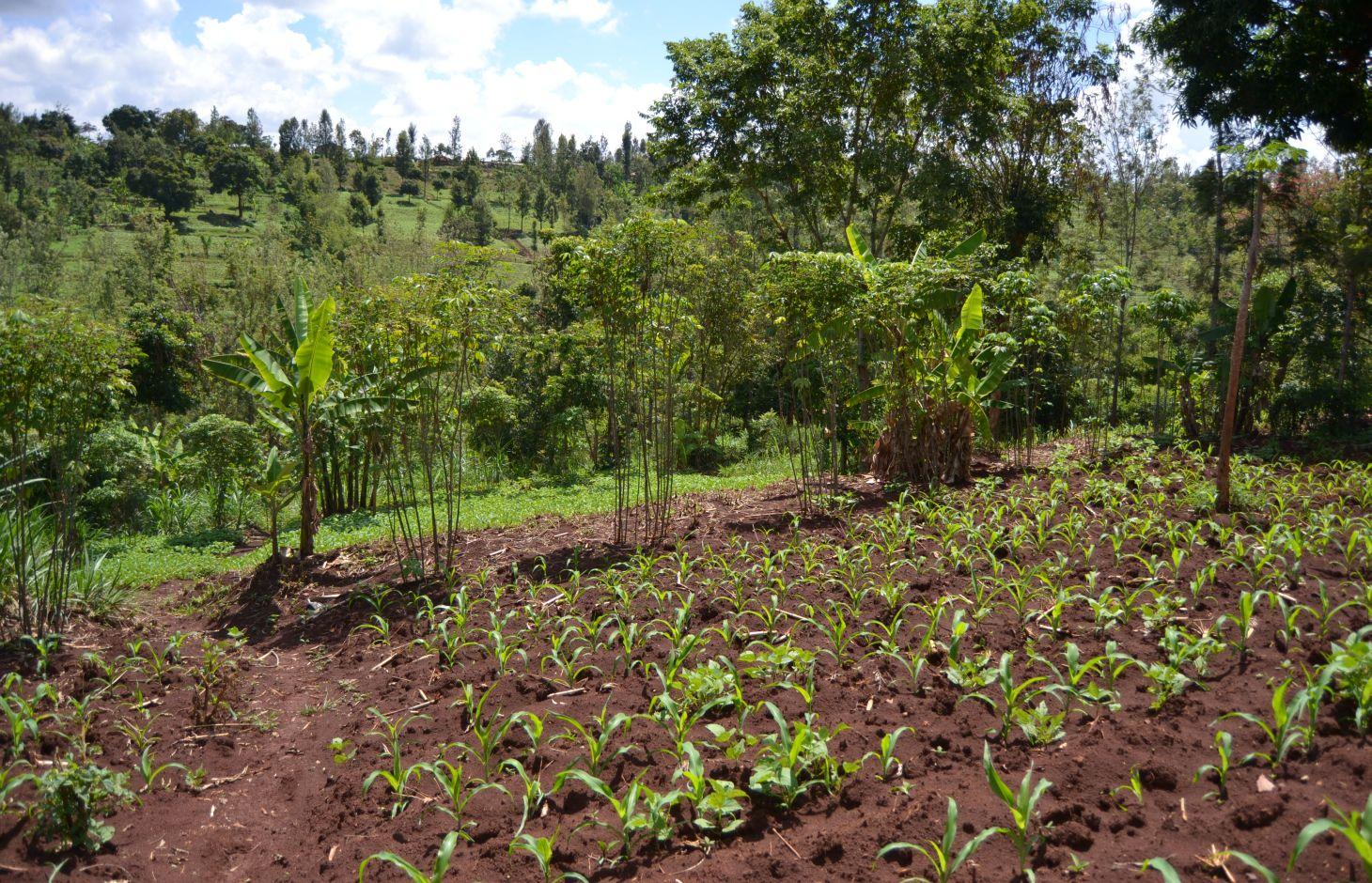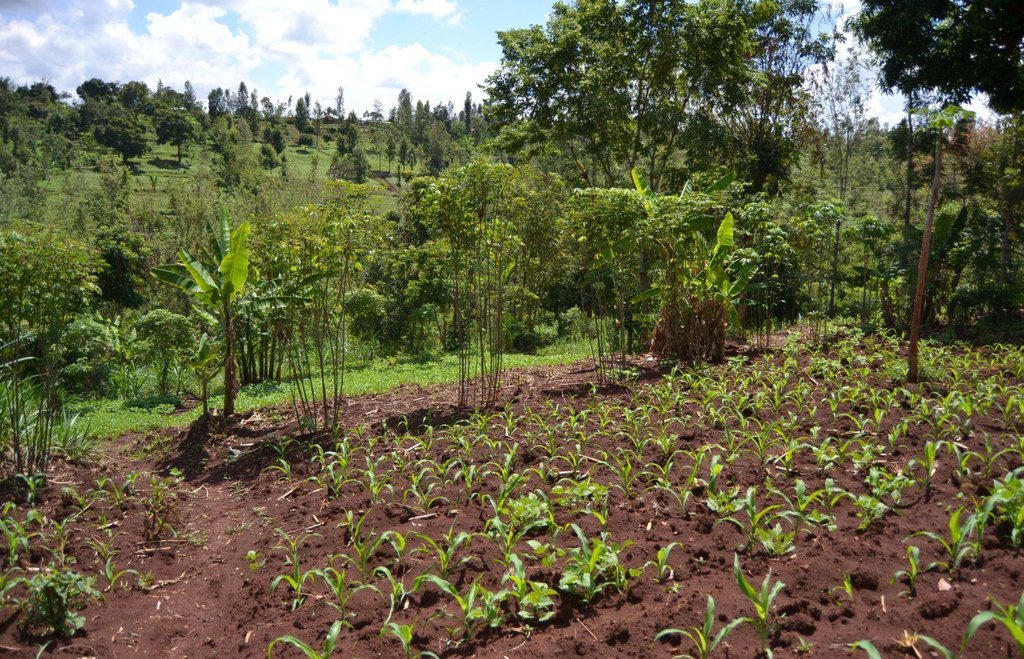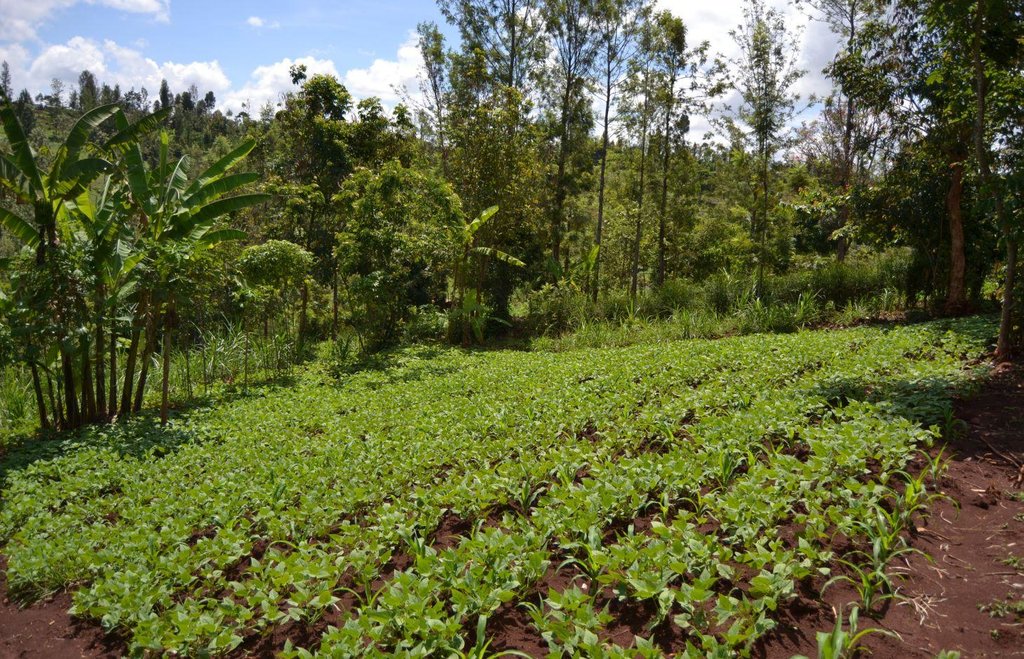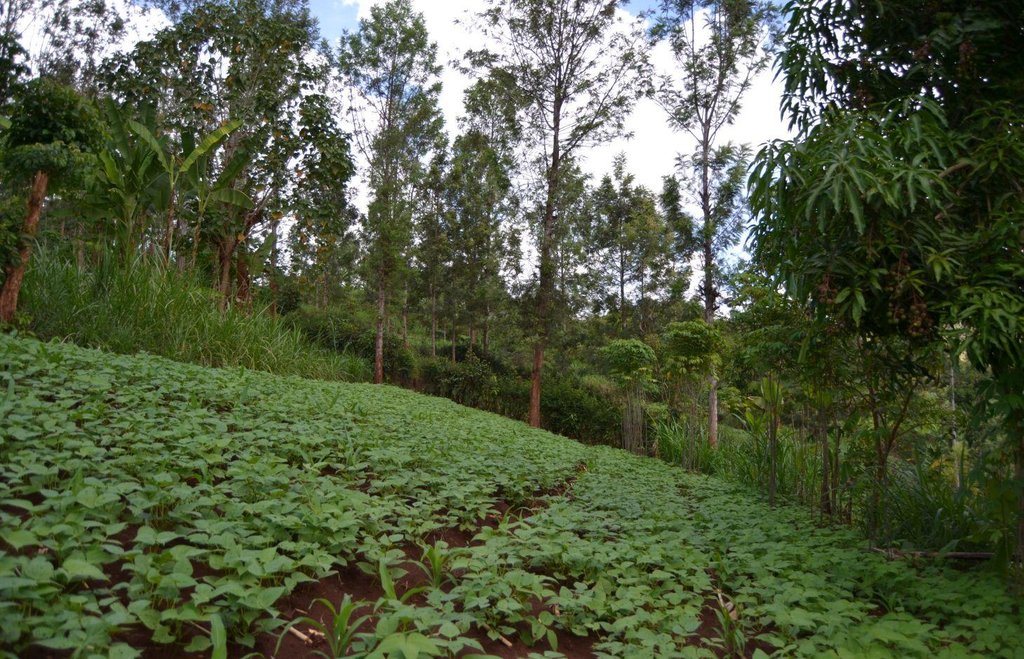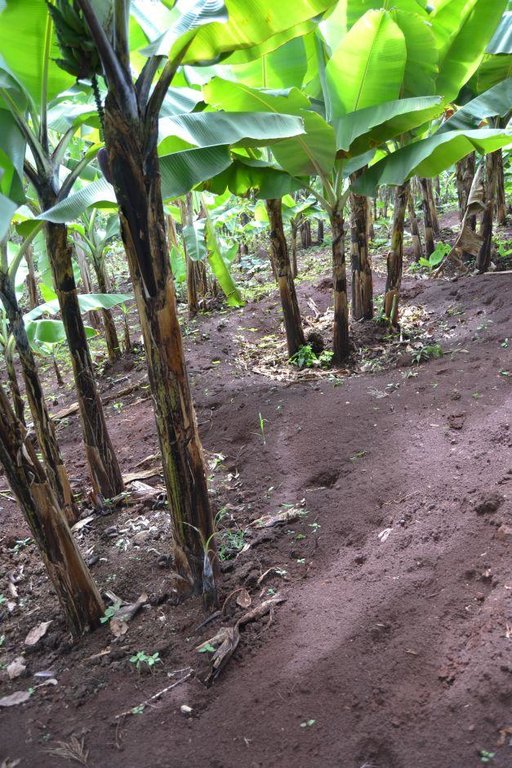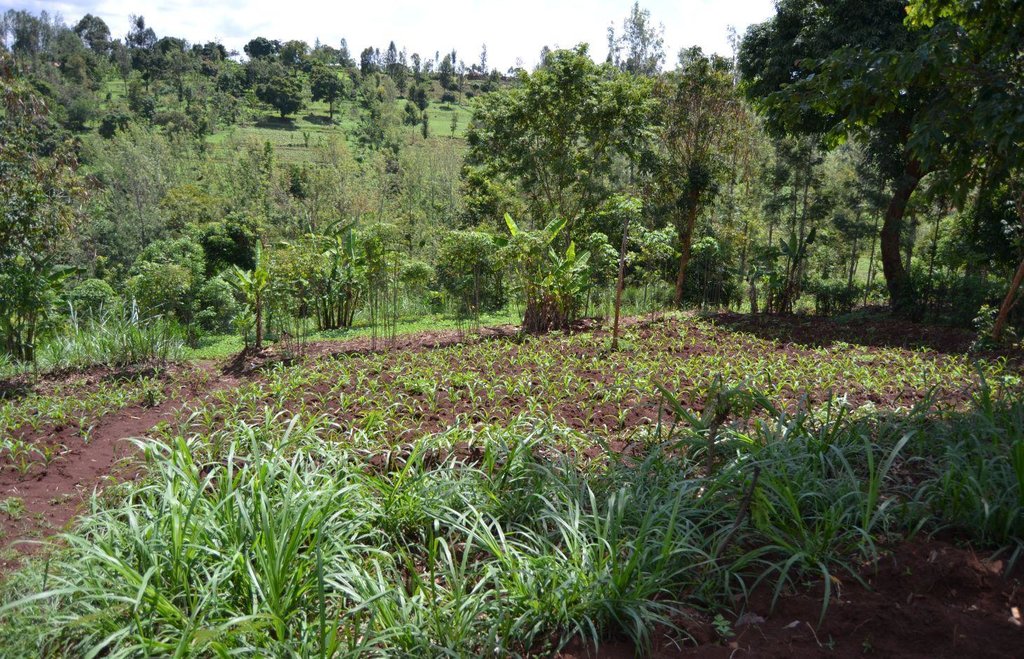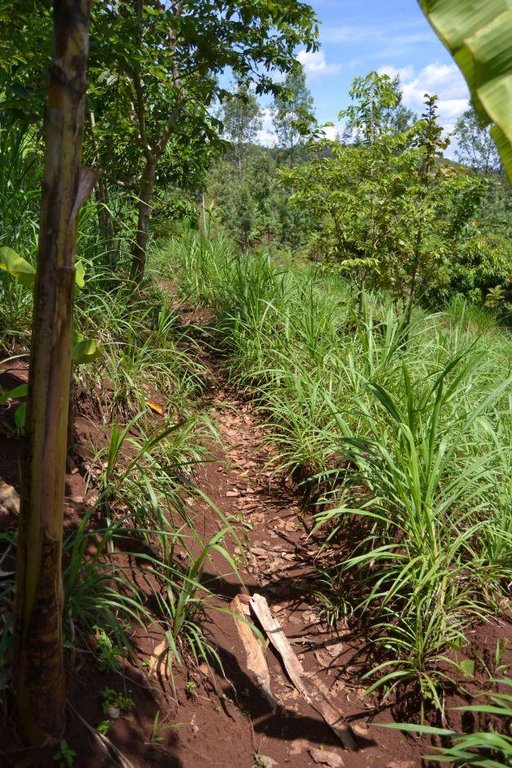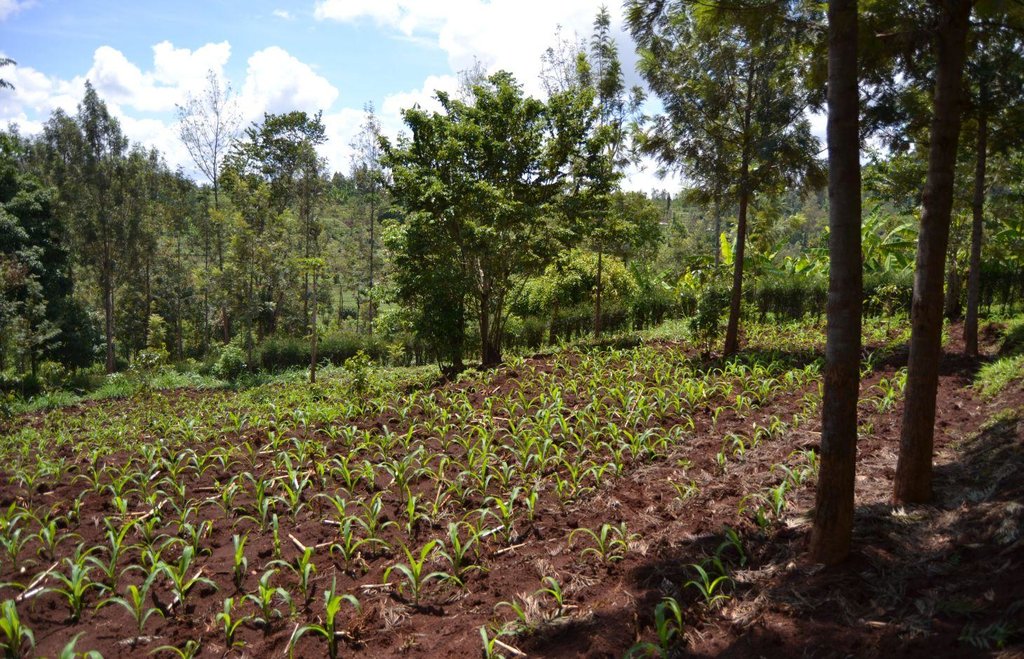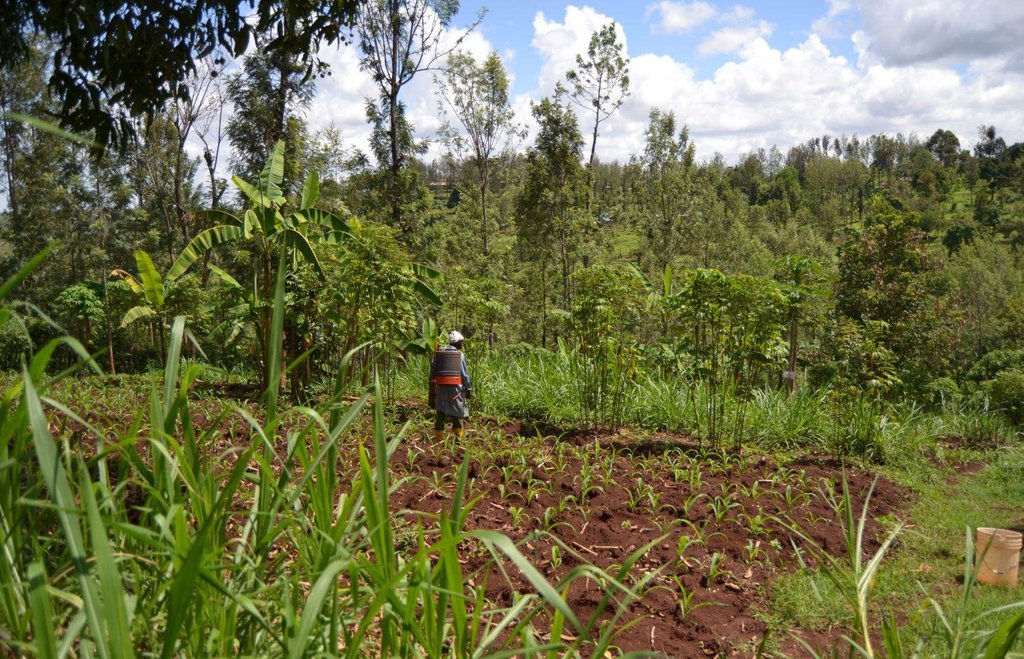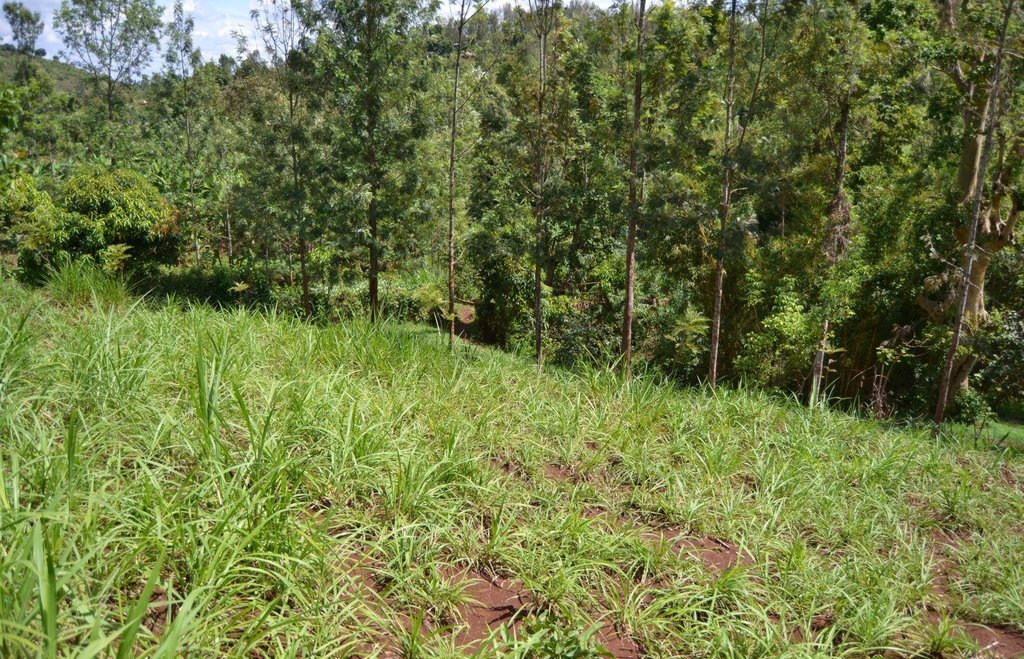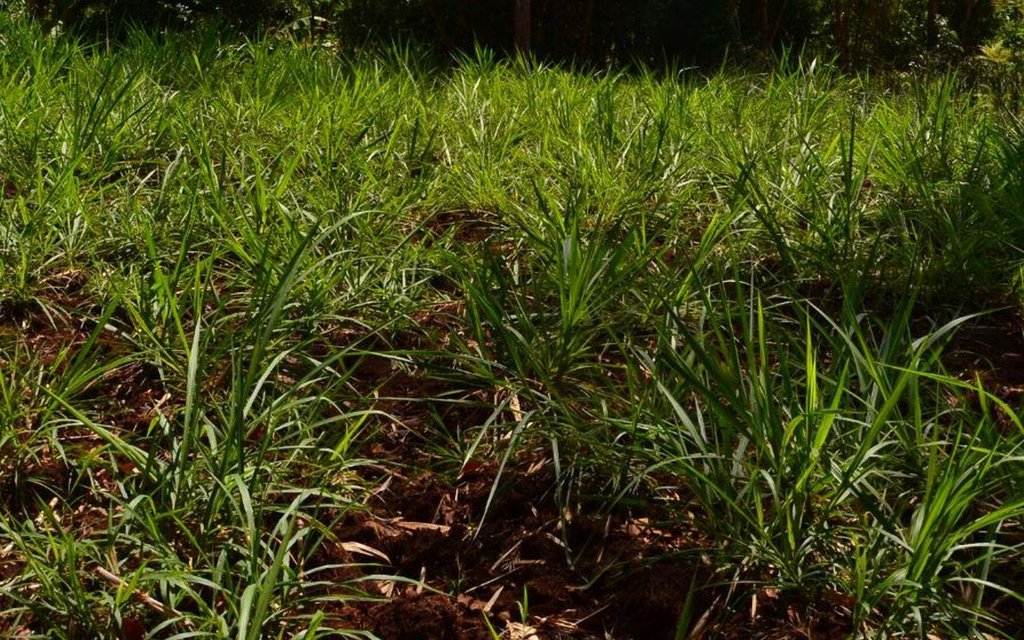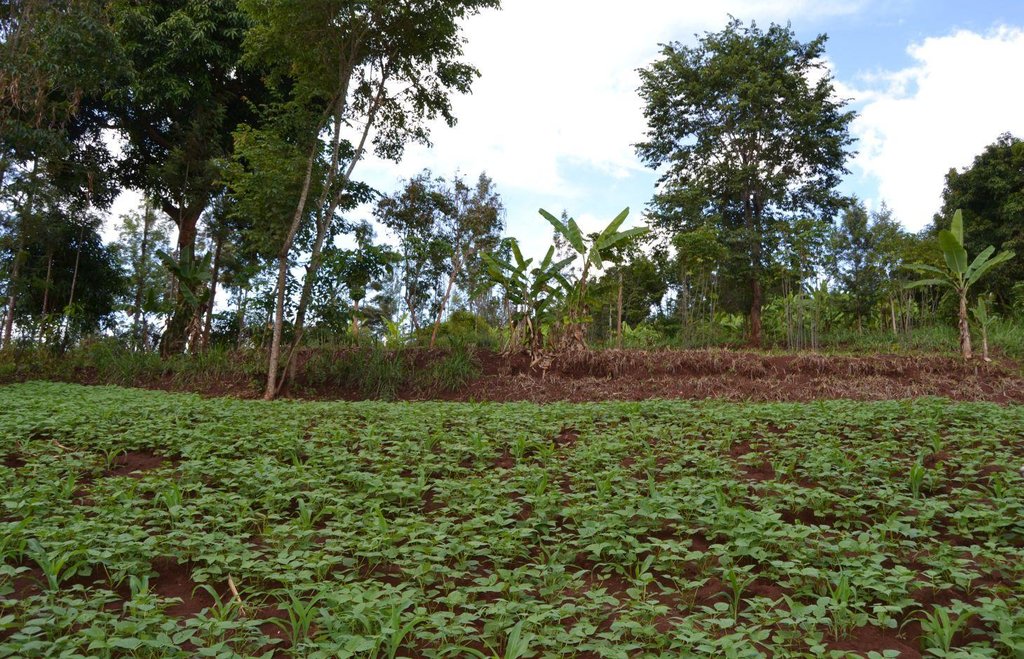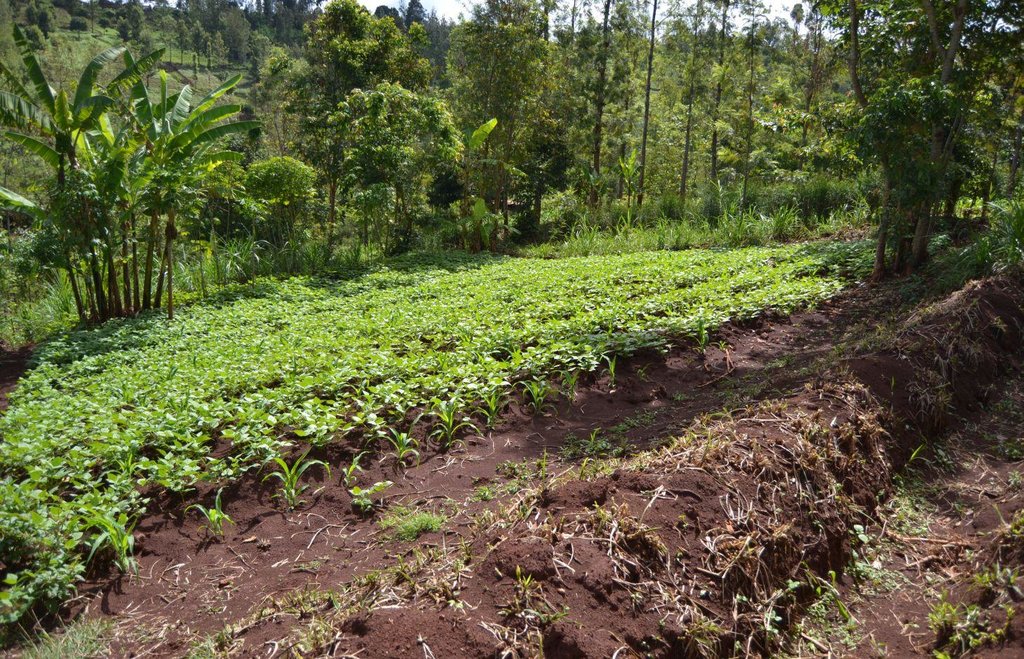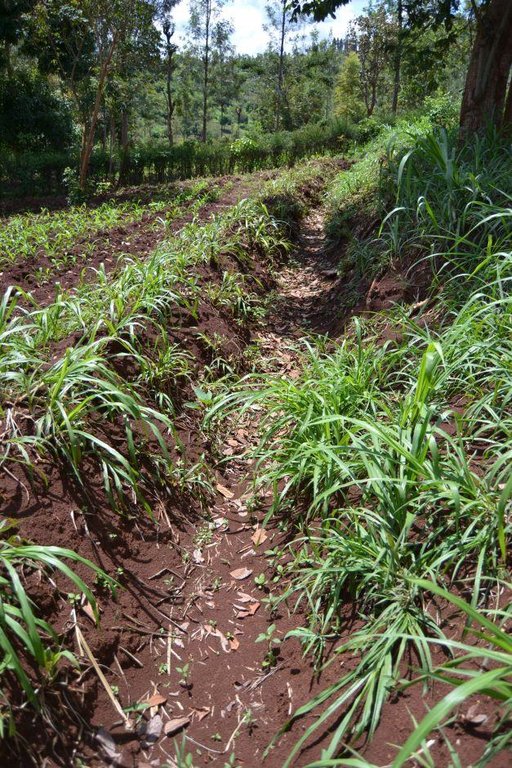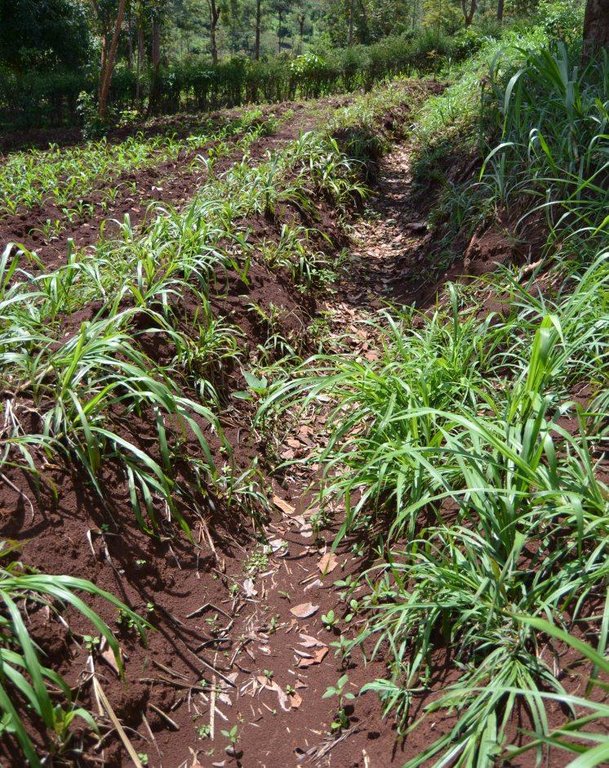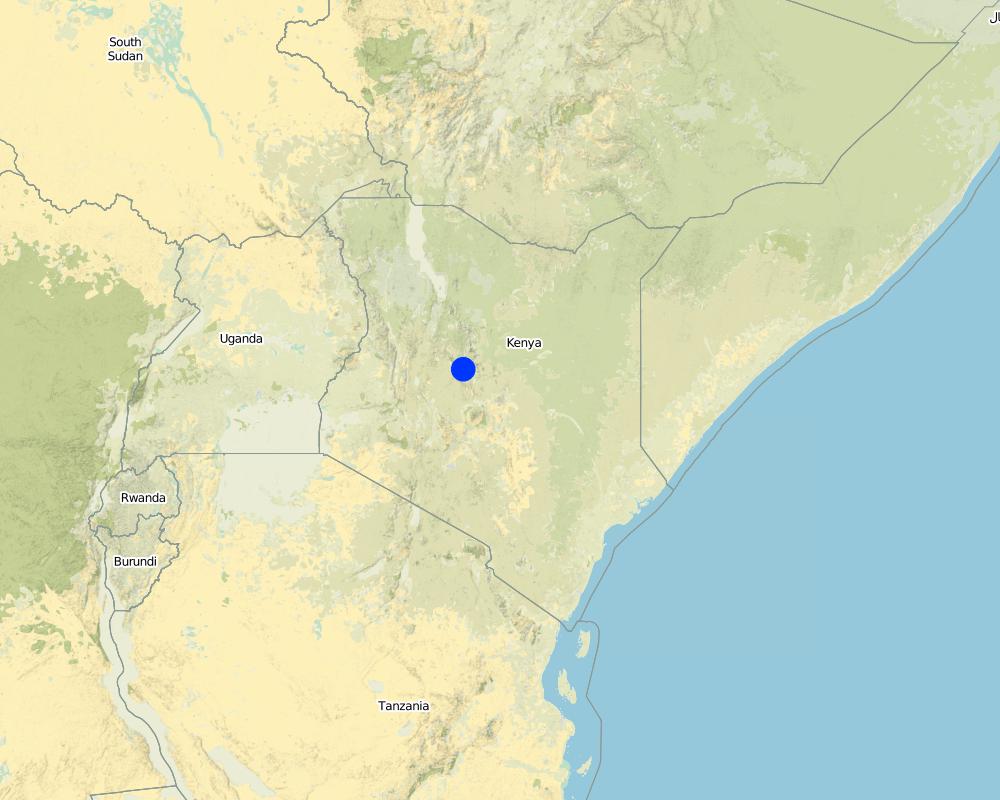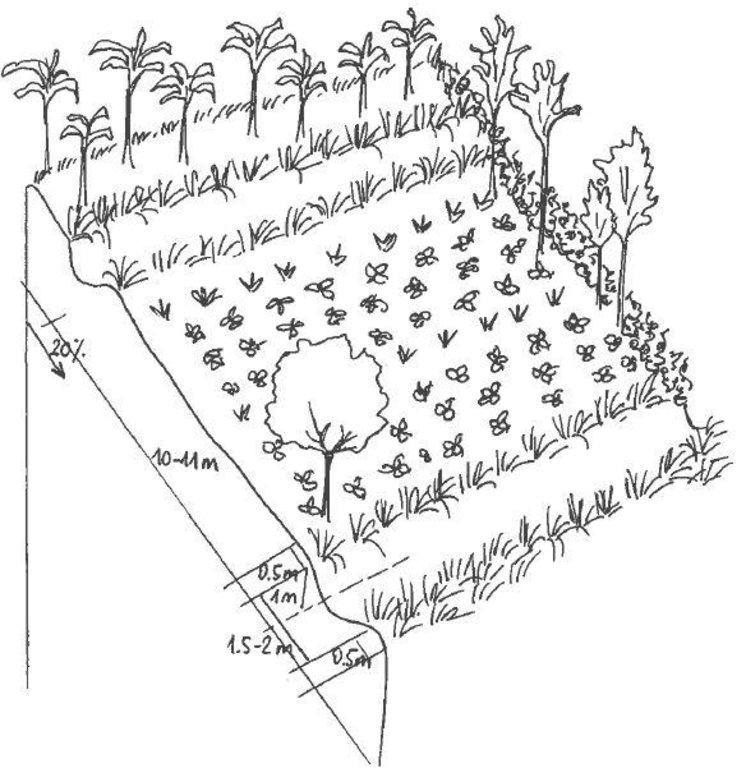Agroforestry system (intercropping beans/maize) with contour ditches, strips of Napier grass, manure and organic fertilizers. [肯尼亚]
- 创建:
- 更新:
- 编制者: Laura D'Aietti
- 编辑者: –
- 审查者: Alexandra Gavilano, Fabian Ottiger
technologies_1146 - 肯尼亚
- Agroforestry system (intercropping beans/maize) with contour ditches, strips of Napier grass, manure and organic fertilizers.: Dec. 28, 2016 (inactive)
- Agroforestry system (intercropping beans/maize) with contour ditches, strips of Napier grass, manure and organic fertilizers.: June 5, 2017 (inactive)
- Agroforestry system (intercropping beans/maize) with contour ditches, strips of Napier grass, manure and organic fertilizers.: May 7, 2019 (public)
查看章节
全部展开 全部收起1. 一般信息
1.2 参与该技术评估和文件编制的资源人员和机构的联系方式
关键资源人
SLM专业人员:
Nyamu Joseph
WRUA Sabasaba
肯尼亚
1.3 关于使用通过WOCAT记录的数据的条件
编制者和关键资源人员接受有关使用通过WOCAT记录数据的条件。:
是
2. SLM技术的说明
2.1 技术简介
技术定义:
The technology is a combination of agricultural (e.g. intercropping, manure/compost/mulching), vegetative (e.g. Napier grass strips, trees planting) and structural (e.g. ditches) measures which aim to maximise the overall land yield in a sustainable manner (e.g. reducing soil erosion and increasing soil quality).
2.2 技术的详细说明
说明:
The Agroforestry system combines trees plantation (Bananas, Grevillea and Avocados) for fruits and timber collection with cereal crop, maize (Zea mays). Indeed, in order to increase yields, strip intercropping is practiced: cereal crop (maize) is grown in association with pulse (food legumes): beans. Instead of using expensive commercial fertilizers, beans could facilitate maize growth due to the possible transfer of N during growth or after incorporation of the legume biomass, during the growth period of the cereal (Sangakkara et al., 2003). Furthermore, soil quality (e.g. soil structure) is improved because of the increased amount of humus and organic matter and a better soil cover helps in preventing splash erosion and increase soil moisture content and therefore fertility. Indeed, beans have a beneficial impact for weed control (probably due to the shadow effects) and soil moisture content (Worfswinkel, undated; Odhiambo and Ariga, 2001). Planting different crops helps to diversify production and family food supply. Concerning SWC, hillside ditches have been created at the top of each 'terrace' and trees are also planted nearby and Cassava (a drought resistant plant) at the bottom. Manure/compost and organic fertilizers are supplied regularly both on maize/grass (twice a year) and Bananas (once), as good soil management practice. A higher level of organic matter in the soil indicates reduced bulk density, improved soil structure, aeration and higher water holding capacity (Olabode et al., 2007), which altogether improve the physical, chemical and biological properties of the soil (Haering and Evanylo, 2005). Bananas are planted in lines in the upper part of the land. The ditches, large 1m are excavated along the contour; they break slope into shorter segments 11 m long to intercept surface runoff. Ditches also help to prevent soil erosion and to avoid that nutrients and organic matter flow easily downwards into the river, instead they fall into the ditch. A live barrier of Napier grass is present above and below the edge of the five ditches, in two lines, to capture sediments and stabilize the structure, thus it is adequately protected. To conclude, a small area of the land is used to plant Napier grass only for fodder for grazing
Purpose of the Technology: Maize and beans are cultivated for home consumption while Avocados and Bananas are planted for economic (commercial) purposes. Fruits are sold out to the middle-men directly from the house (not at the market), to reduce costs (e.g. transport) and time. Avocados are sold at about 2.5/3 Ksh and Bananas at 200 Ksh. Grevillea trees are considered as saving, and sold out for timber production when the farmer is in need of cash, earning between 800 up to 1500 Ksh, depending on the size-lenght of the tree and the costs for cutting-transportation (e.g. machine operator). In general the selling of timber occurs per feet (running feet). ‘Whole” or standing tree is the preferred mode of selling trees from farms. Negotiation on sales is per tree ‘standing on farm’, with no processing or conversion. Buyers cut and cross cut, and carry timber from farms. Branches and slabs resulting from timber recoveries are left with the farmer depending on price negotiation; if the buyer carries these products then the price of the tree is adjusted upwards (Carsan and Holding , 2006; Holding et al., undated). Furthermore, the farmer underlined how 'bad prunings' at the top of the trees cause holes inside the trunks and thus a higher risk of fungi attacks and other diseases. The majority of the trees are planted along the boundaries of the land, for demarcation and only few are 'dispersed' on the cropland, to avoid excess of shadow to the cereal crop
Establishment / maintenance activities and inputs: High initial input to construct ditches and planting crop; manure also requires regular work: feeding cows and collect droppings and distribute them twice during the year, also over Napier grass. Dry planting is the preferred practice and the seeds are soaked the night before planting; this practice is advisable especially when the growing period is very short (Schmidt et al., 1983); organic fertilizers are applied over maize after 1 week and during the growing period (after about 18 days). Further maintenance is necessary after every rainy season to remove the sediments accumulated into the ditch and for pruning Grevillea, every three seasons. As mentioned above, pruning requires skills and knowledge to avoid plant diseases and labour is expensive because it is high risk work. The farmer trees plantation account for: 15 Avocados (from 4 seedlings), 100 Bananas (from cutting new suckers) and 50 Grevillea trees
Natural / human environment: The area is characterized by rolling-hilly slope and highly exposed to erosion and land degradation: planting trees protect the soil from nutrients leaching and create a litter which reduces evaporation during dry seasons. Concerning the variety of the trees, (e.g. Avocado) the farmer by grafting with better quality branches, improve the quality of the stock trees with certified variesties: out of 4 seedlings of Avocado (10 Ksh each), he has now 15 seedlings of the better (certified) variety called HASS, which performs well at 800-2100 m asl with well distributed annual rainfall of 1000-1200 mm (Youth Agro-environmental initiative website)
2.3 技术照片
2.5 已应用该技术的、本评估所涵盖的国家/地区/地点
国家:
肯尼亚
区域/州/省:
Central
有关地点的进一步说明:
Muthithi location, Kagurumo sublocation
具体说明该技术的分布:
- 均匀地分布在一个区域
如果技术均匀分布在一个区域,则指定覆盖的区域(单位为平方千米):
0.008
如果不知道精确的区域,请注明大致覆盖的区域:
- < 0.1 平方千米(10 公顷)
注释:
Total area covered by the SLM Technology is 0.008 km2.
GATWAMIKWA village
Map
×2.6 实施日期
如果不知道确切的年份,请说明大概的日期:
- 不到10年前(最近)
2.7 技术介绍
详细说明该技术是如何引入的:
- 通过土地使用者的创新
注释(项目类型等):
Since the year 2000 the farmer adopted SWC practices in respond to the prolonged degraded situation of the land and its low yields.
3. SLM技术的分类
3.2 应用该技术的当前土地利用类型
同一土地单元内混合使用的土地::
是
具体说明混合土地使用(作物/放牧/树木):
- 农林牧业

农田
- 一年一作
- 多年一作(非木材)
- 乔木与灌木的种植
年作 - 具体指明作物:
- 谷物类 - 玉米
- 饲料作物 - 草
- 豆科牧草和豆类 - 豆子
多年生(非木质)作物 - 指定作物:
- 香蕉/芭蕉/蕉麻
乔木和灌木种植 - 指定作物:
- 鳄梨
每年的生长季节数:
- 2
具体说明:
Longest growing period in days: 122Longest growing period from month to month: from about March to JuneSecond longest growing period in days: 61Second longest growing period from month to month: from about October to November
采用间作制度了吗?:
是
如果是,说明哪些作物是间作的:
Intercropping of maize and beans: the distance from one line of maize and the other is of 1m.

牧场
集约放牧/饲料生产:
- 收割和携带/零放牧
- cows

森林/林地
- 植树造林
树木类型:
- 银桦
产品和服务:
- 木材
- 水果和坚果
注释:
Trees/ shrubs species: Grevillea (Grevillea robusta)
Fruit trees / shrubs species: Avocados (Persea americana- Mũkorobia), Bananas (Musa sapientum- Irigũ)
Grass species: Pennisetum pyramidalis (Napier grass or elephant grass)
Main crop: Maize (Zea mays) and beans
Main animal species and products: Cut-and-carry/ zero grazing: Fodder is provided to animals (2 cows) confined to a stall.
Major land use problems (compiler’s opinion): Sheet erosion with consequent nutrient leaching which could drain into the river.
Major land use problems (land users’ perception): Loss of soil fertility.
Grazingland comments: Fig. 10 Annex 3
Plantation forestry: Yes
Type of grazing system comments: Fig. 10 Annex 3
Livestock density: < 1 LU/km2
3.4 供水
该技术所应用土地的供水:
- 雨养
3.6 包含该技术的可持续土地管理措施

农艺措施
- A1:植被和土壤覆盖层
- A2:有机质/土壤肥力
- A3:土壤表面处理

植物措施
- V1:乔木和灌木覆盖层
- V2:草和多年生草本植物

结构措施
- S4:平沟、坑
注释:
Main measures: vegetative measures, structural measures
Secondary measures: agronomic measures
Type of agronomic measures: mulching, legume inter-planting, manure / compost / residues
Type of vegetative measures: aligned: -graded strips *<sup>3</sup>
3.7 该技术强调的主要土地退化类型

土壤水蚀
- Wt:表土流失/地表侵蚀

化学性土壤退化
- Cn:肥力下降和有机质含量下降(非侵蚀所致)

水质恶化
- Hp:地表水水质下降
注释:
Main causes of degradation: soil management (Poor soil management practices.), deforestation / removal of natural vegetation (incl. forest fires) (Poor vegetation cover, mainly herbaceous), disturbance of water cycle (infiltration / runoff) (Steep area (runoff)), Heavy / extreme rainfall (intensity/amounts) (Especially during wet seasons: March-June and October-November), education, access to knowledge and support services (Limited knowledge and training on SWC practices), governance / institutional (Limited or not adequate support)
Secondary causes of degradation: other natural causes (avalanches, volcanic eruptions, mud flows, highly susceptible natural resources, extreme topography, etc.) specify (From gentle to hilly slope), land tenure (Previous poor management SWC measures, especially in the upper areas)
3.8 防止、减少或恢复土地退化
具体数量名该技术与土地退化有关的目标:
- 防止土地退化
- 减少土地退化
4. 技术规范、实施活动、投入和成本
4.1 该技术的技术图纸
技术规范(与技术图纸相关):
Agroforestry system, which covers an area of 2 acre. The plot is bordered by Euphorbia tirucalli (Kariaria, milk bush) and Grevillea trees. The ditches are characterized by barriers of Napier grass. Intercropping of maize and beans: the distance from one line of maize and the other is of 1m.
Technical knowledge required for land users: moderate
Main technical functions: control of dispersed runoff: retain / trap, control of dispersed runoff: impede / retard, reduction of slope angle, reduction of slope length, improvement of ground cover, increase of infiltration, increase / maintain water stored in soil, water harvesting / increase water supply, sediment retention / trapping, sediment harvesting
Secondary technical functions: improvement of topsoil structure (compaction), stabilisation of soil (eg by tree roots against land slides), increase in organic matter, increase in nutrient availability (supply, recycling,…), improvement of water quality, buffering / filtering water, increase of biomass (quantity)
Mulching
Material/ species: Organic residues around Banana trees
Quantity/ density: undefined
Legume inter-planting
Quantity/ density: 4 kg
Manure / compost / residues
Material/ species: Leftovers and manure from two cows
Quantity/ density: 8 tonnes
Remarks: (for 1 year). The mix of organic material is left decomposed in a big hole.
Agronomic measure: organic fertilizers
Material/ species: Acid humic and N, P, K, microelements (Biodeposit Elixir: small bags (sachets) of 12 ml)
Remarks: 5 bags (1×12 litre), applied only on maize
Aligned: -graded strips
Vegetative material: T : trees / shrubs, F : fruit trees / shrubs, G : grass
Number of plants per (ha): 100 a strip
Vertical interval between rows / strips / blocks (m): few cm
Spacing between rows / strips / blocks (m): 1
Vertical interval within rows / strips / blocks (m): 0.25
Width within rows / strips / blocks (m): 1
Trees/ shrubs species: Grevillea (Grevillea robusta)
Fruit trees / shrubs species: Avocados (Persea americana- Mũkorobia), Bananas (Musa sapientum- Irigũ)
Grass species: Pennisetum pyramidalis (Napier grass or elephant grass)
Slope (which determines the spacing indicated above): 10%
If the original slope has changed as a result of the Technology, the slope today is (see figure below): 15%
Gradient along the rows / strips: 5-8%
Diversion ditch/ drainage
Spacing between structures (m): 1
Depth of ditches/pits/dams (m): 40/50
Width of ditches/pits/dams (m): 0.6/1
Slope (which determines the spacing indicated above): 5-8%
Lateral gradient along the structure: 15-20%
作者:
D'Aietti Laura
4.2 有关投入和成本计算的一般信息
其它/国家货币(具体说明):
Kenyan Schellings
如相关,注明美元与当地货币的汇率(例如1美元=79.9巴西雷亚尔):1美元=:
85.9
注明雇用劳工的每日平均工资成本:
2.00
4.3 技术建立活动
| 活动 | 时间(季度) | |
|---|---|---|
| 1. | Digging holes (1 feet ×1 feet) and planting trees (e.g. Grevillea trees along the boundaries and in line below the bunds of the ditches) | March (before rains), 1 year |
| 2. | Establishment of the ditches(digging ditch and creating soil bunds donward) and terracing. For 1 (in tot. are 5) : 2 p.d. * 1 day at 200 Ksh a day each. | 2 times per year |
| 3. | Digging the hole (3m×3m×1.5m) where to compost | |
| 4. | Machine to grill/mill maize leftovers (chap cutter) | |
| 5. | Purchase 2 cows | |
| 6. | Purchase generator |
注释:
Life span of the machine to grill, the cows and the generator: Several years
4.4 技术建立所需要的费用和投入
| 对投入进行具体说明 | 单位 | 数量 | 单位成本 | 每项投入的总成本 | 土地使用者承担的成本% | |
|---|---|---|---|---|---|---|
| 劳动力 | Digging the hole (3m×3m×1.5m) where to compost | person/days | 2.0 | 3.5 | 7.0 | 100.0 |
| 劳动力 | Digging holes (1 feet ×1 feet) and planting trees | person/days | 2.0 | 3.5 | 7.0 | 100.0 |
| 劳动力 | Establishment of the ditches (digging ditch and creating soil bunds donward) and terracing | person/days | 10.0 | 23.3 | 233.0 | 100.0 |
| 设备 | Machine to grill/mill maize leftovers (chap cutter) | piece | 1.0 | 1164.0 | 1164.0 | 100.0 |
| 设备 | Generator | piece | 1.0 | 582.0 | 582.0 | 100.0 |
| 设备 | Cow | piece | 2.0 | 349.0 | 698.0 | 100.0 |
| 植物材料 | Seedlings Grevillea | pieces | 54.0 | 0.1111 | 6.0 | 100.0 |
| 技术建立所需总成本 | 2697.0 | |||||
| 技术建立总成本,美元 | 31.4 | |||||
注释:
Duration of establishment phase: 6 month(s)
4.5 维护/经常性活动
| 活动 | 时间/频率 | |
|---|---|---|
| 1. | Prepare and apply fertilizers (organic) (See Annex 3, Fig. 9&comments) | Ferlizer application: after 1 week and 18 days, on maize only |
| 2. | Prepare manure+compost/mulch (Summary 2.1.2 QT4): Labour (to grill/mill leftovers - 300 Ksh for fuel- leftovers to prepare food for cows-3 person days) rest, the farmer by himself feed cows on daily basis (3 times in a day). Fuel: 1litre×1 day (×3 days) | compost/manure: 2 times/year in the field+grass; once on Bananas (where also added mulch) |
| 3. | Harvesting maize/beans (around Feb/March and Ag/Sept) | 2 times |
| 4. | Apply manure, mulch and compost (during March/April-long rains+Sept) just before the rains, when nutrients infiltrate into the soil with rainwater) (Summary 2.1.2 QT4) | Compost/manure: 2 times/year in the field+grass; once on Bananas (where also added mulch) |
| 5. | Tilling-soil (digging holes to plant maize/beans: 7 inches deep (17cm), spaced 1 feet (0.30 m) in contours: dry planting (before rains starts) | Twice a year, before rainy season (around March/Sept) |
| 6. | Digging planting holes and planting grass (2 persons × 3 days: 200 Ksh) | Every season (March/April and Sept/Oct) |
| 7. | Maintenance (weed control and cutting Napier grass and collecting fodder) (Fig. 11 Annex 3) | Every season (March/Sept); cutting Napier: 3/4 times in a season |
| 8. | Pruning branches and let them dry for firewood | Every 3 seasons (and when shortage of firewood) |
| 9. | Clearing the tree for selling timber (the price depends also of the use of the chainsaw (or saw) or not | When in need of cash (not regularly), not less than 5 years after planting |
| 10. | Repairing the ditches and remove excess of soil/leaves accumulated during the rainy season | After rains (every season) |
4.6 维护/经常性活动所需要的费用和投入(每年)
| 对投入进行具体说明 | 单位 | 数量 | 单位成本 | 每项投入的总成本 | 土地使用者承担的成本% | |
|---|---|---|---|---|---|---|
| 劳动力 | Prepare and apply fertilizers (organic) | person/days | 2.0 | 2.0 | 4.0 | 100.0 |
| 劳动力 | Prepare manure+compost/mulch | person/days | 3.0 | 2.0 | 6.0 | 100.0 |
| 劳动力 | Digging planting holes and planting grass | person/days | 6.0 | 2.0 | 12.0 | 100.0 |
| 劳动力 | Maintenance (weed control and cutting Napier grass and collecting fodder) | person/days | 5.0 | 12.0 | 60.0 | 100.0 |
| 设备 | Fuel | l | 3.0 | 1.0 | 3.0 | 100.0 |
| 植物材料 | Seedlings grass (per ha) | pieces | 100.0 | |||
| 肥料和杀菌剂 | Organic fertilizer (Biodeposit Elixir) from Thika | ml | 12.0 | 1.0 | 12.0 | 100.0 |
| 其它 | Labour: Pruning branches and let them dry for firewood | person/days | 1.0 | 4.0 | 4.0 | 100.0 |
| 其它 | Labour: Clearing the tree for selling timber | person/days | 1.0 | 7.0 | 7.0 | 100.0 |
| 其它 | Labour: Repairing the ditches and remove excess of soil/leaves accumulated during the rainy season | person/days | 2.0 | 2.0 | 4.0 | 100.0 |
| 技术维护所需总成本 | 112.0 | |||||
| 技术维护总成本,美元 | 1.3 | |||||
注释:
Machinery/ tools: the farmer prefers to use fork djembe then just the normal djembe (because it removes better the soil); panga and hoes, shovel, fork djembe, panga, saw, shovels
The costs has been computed during the period of the field visit and it include all the costs for the different structures: agronomic, vegetative and structural measures for 2 acre of land and summarized for 1 year period.
4.7 影响成本的最重要因素
描述影响成本的最决定性因素:
The main environmental constrain is water, in particular during dry season; An important cost is labour required to maintain all the SWC measures.
5. 自然和人文环境
5.1 气候
年降雨量
- < 250毫米
- 251-500毫米
- 501-750毫米
- 751-1,000毫米
- 1,001-1,500毫米
- 1,501-2,000毫米
- 2,001-3,000毫米
- 3,001-4,000毫米
- > 4,000毫米
农业气候带
- 半湿润
Thermal climate class: subtropics. June, July and August
5.2 地形
平均坡度:
- 水平(0-2%)
- 缓降(3-5%)
- 平缓(6-10%)
- 滚坡(11-15%)
- 崎岖(16-30%)
- 陡峭(31-60%)
- 非常陡峭(>60%)
地形:
- 高原/平原
- 山脊
- 山坡
- 山地斜坡
- 麓坡
- 谷底
垂直分布带:
- 0-100 m a.s.l.
- 101-500 m a.s.l.
- 501-1,000 m a.s.l.
- 1,001-1,500 m a.s.l.
- 1,501-2,000 m a.s.l.
- 2,001-2,500 m a.s.l.
- 2,501-3,000 m a.s.l.
- 3,001-4,000 m a.s.l.
- > 4,000 m a.s.l.
5.3 土壤
平均土层深度:
- 非常浅(0-20厘米)
- 浅(21-50厘米)
- 中等深度(51-80厘米)
- 深(81-120厘米)
- 非常深(> 120厘米)
土壤质地(表土):
- 中粒(壤土、粉土)
表土有机质:
- 低(<1%)
5.4 水资源可用性和质量
地下水位表:
> 50米
地表水的可用性:
中等
水质(未处理):
良好饮用水
5.5 生物多样性
物种多样性:
- 中等
5.6 应用该技术的土地使用者的特征
非农收入:
- > 收入的50%
相对财富水平:
- 丰富
个人或集体:
- 个人/家庭
机械化水平:
- 手工作业
说明土地使用者的其他有关特征:
Population density: 10-50 persons/km2
Annual population growth: 2% - 3%
Off-farm income specification: The farmer is rich because he owns 3 acre of land and livestock, assets (electricity) which are above the average standards of the community. The farmer is retired from an accountancy service position several years ago.
Market orientation of production system: subsistence (self-supply), subsistence (self-supply), commercial/ market
5.7 应用该技术的土地使用者使用的平均土地面积
- < 0.5 公顷
- 0.5-1 公顷
- 1-2 公顷
- 2-5公顷
- 5-15公顷
- 15-50公顷
- 50-100公顷
- 100-500公顷
- 500-1,000公顷
- 1,000-10,000公顷
- > 10,000公顷
5.8 土地所有权、土地使用权和水使用权
土地所有权:
- 个人,有命名
土地使用权:
- 个人
用水权:
- 自由进入(无组织)
注释:
Water use rights depend on the use: open access for drinking and domestic uses.
5.9 进入服务和基础设施的通道
健康:
- 贫瘠
- 适度的
- 好
教育:
- 贫瘠
- 适度的
- 好
技术援助:
- 贫瘠
- 适度的
- 好
就业(例如非农):
- 贫瘠
- 适度的
- 好
市场:
- 贫瘠
- 适度的
- 好
能源:
- 贫瘠
- 适度的
- 好
道路和交通:
- 贫瘠
- 适度的
- 好
饮用水和卫生设施:
- 贫瘠
- 适度的
- 好
金融服务:
- 贫瘠
- 适度的
- 好
6. 影响和结论性说明
6.1 该技术的现场影响
社会经济效应
生产
作物生产
木材生产
收入和成本
农业投入费用
农业收入
社会文化影响
社会经济弱势群体的情况
生态影响
水循环/径流
地表径流
蒸发
土壤
土壤水分
土壤覆盖层
土壤流失
生物多样性:植被、动物
生物量/地上C
6.2 该技术的场外影响已经显现
水资源可用性
缓冲/过滤能力
6.3 技术对渐变气候以及与气候相关的极端情况/灾害的暴露和敏感性(土地使用者认为的极端情况/灾害)
渐变气候
渐变气候
| 季节 | 增加或减少 | 该技术是如何应对的? | |
|---|---|---|---|
| 年温度 | 增加 | 未知 |
气候有关的极端情况(灾害)
气象灾害
| 该技术是如何应对的? | |
|---|---|
| 局地暴雨 | 好 |
| 局地风暴 | 好 |
气候灾害
| 该技术是如何应对的? | |
|---|---|
| 干旱 | 不好 |
水文灾害
| 该技术是如何应对的? | |
|---|---|
| 比较和缓的(河道)洪水 | 好 |
其他气候相关的后果
其他气候相关的后果
| 该技术是如何应对的? | |
|---|---|
| 缩短生长期 | 未知 |
6.4 成本效益分析
技术收益与技术建立成本相比如何(从土地使用者的角度看)?
短期回报:
轻度消极
长期回报:
稍微积极
技术收益与技术维护成本/经常性成本相比如何(从土地使用者的角度看)?
短期回报:
稍微积极
长期回报:
积极
6.5 技术采用
注释:
100% of land user families have adopted the Technology without any external material support
There is a moderate trend towards spontaneous adoption of the Technology
6.7 该技术的优点/长处/机会
| 土地使用者眼中的长处/优势/机会 |
|---|
| Better yields thanks to the intercropping measures taken. |
| 编制者或其他关键资源人员认为的长处/优势/机会 |
|---|
|
Intercropping is a commonly known practice which improves the overall conditions of the soil and provide better yields. How can they be sustained / enhanced? Besides 'companion planting' there are plants which can be grown as forerunner plants (Storey, 2002). Depending also on the type of soil, attention could be given to some sps. which accumulate concentration of e.g. mineral accumulators, phosporus, potassium, calcium, silica and sulphur . Another way to perhaps enhance the yields is relay intercropping. It is undersowing the next crop into the present crop, so that the present crop is a nurse crop and time and water is saved in the establishment of the following crop (Storey, 2002) Green manure as a way to add organic nutrients and combine more than one green manure and rotate, both legume (e.g. cowpeas, soybeans, annual sweet clover, vetch, sesbania, and velvet beans ) and not legume (e.g. sudangrass, millet, sorghum, and buckwheat). |
|
Agroforestry (Dispersed trees on cropland): The technology is simple to adopt and improves a sustainable land management as well as diversification of income sources and food supply. How can they be sustained / enhanced? It could be implemented by increasing the number of trees planted (e.g. along the boundaries) and with sps. characterised by deeper root systems, to avoid further water competition. More Avocadoe trees could increase the opportunities for the farmer to be part of a CBO (Community Based Organization) addressed to marketing of Avocadoes for oil production. This could help the farmer to earn more money and invest more in SWC implementation and new methods, in the long run. The option of alley cropping (hedgerow Intercropping) with leguminous plants e.g. Sesbanian sesban (Ramachandran Nair-ICRAF, 1993) could be considered as another option. |
|
Napier grass has very good properties in holding soil; also for ditch stabilization and fodder production How can they be sustained / enhanced? Other herbaceous vegetation could be also planted in the field: e.g. Tithonia diversifolia (Mexican sunflower), an excellent (high quality-N, P, K concentration) green manure /nutrient release and medicinal plant, or could be also used as a major component of compost manure. It is an annual weed that can be used for several purposes: fodders, poultry feed, fuel, compost, land demarcation, soil erosion, building materials, shelter for poultry. It is characterized by adaptability to different environment, rapid growth, fast rate of decomposition. Nevertheless, there is the need to ascertain the extent to which this weed sps. could be used for soil improvement and to determine the best mode of application of the weed sps., (Olabode et al., 2007, Olubukola et al., 2013) and the fact that is a invasive weed (with an aggressive growth) it requires a good knowledge in the land management and weed control. |
| The attention to certified varieties give also more value to the production itself and at market level: an increase of the bargaining power creates more opportunities for better income and chances to explore new and bigger markets, (e.g. Avocados for oil production ). |
6.8 技术的弱点/缺点/风险及其克服方法
| 编制者或其他关键资源人员认为的弱点/缺点/风险 | 如何克服它们? |
|---|---|
| The technologies in place require maintenance and monitoring, especially during rainy seasons | Eventually subsides or be part of a CBO's (Community Based Organizations) or SHG (Self Help Groups); Still the measures already in place could be improved: diversification of trees (e.g. indigenous) and trainings (e.g. pruning etc) could help the farmer in avoiding tree diseases and allocate more efficiently resources. |
| The amount of work required to carry out all the activities is too much. |
7. 参考和链接
7.1 信息的方法/来源
7.2 参考可用出版物
标题、作者、年份、ISBN:
Holding C., Carsan S., Njuguna P., 2004. Smallholder Timber Marketing: A Kenyan Experience. FAO/ICRAF/GoK multi-stakeholder programme. International Workshop on small holder timber production.
标题、作者、年份、ISBN:
Odhiambo G.D. and Ariga E. S., 2001. Effect of intercropping maize and beans on Striga incidence and grain yield. Seventh Eastern and Southern Africa Regional Maize Conference. 11th -15 th February, 2001. pp. 183-186.
标题、作者、年份、ISBN:
Olabode O.S., Sola O., Akanbi W.B., Adesina G.O., Babajide P.A., 2007. Evaluation of Tithonia diversifolia (Hemsl.) A Gray for Soil Improvement. World Journal of Agricultural Sciences 3 (4): 503-507.
可以从哪里获得?成本如何?
http://www.idosi.org/wjas/wjas3(4)/15.pdf
标题、作者、年份、ISBN:
Olubukola S. A., Aderemi Ojo Ezekiel-Adewoyin O., Dorcas Tinuke D., Akintoye Henry, 2010. Comparing the use of Tithonia diversifolia and Compost as soil amendments for growth and yield of Celosia argentea. New York Science Journal 3 (6).
可以从哪里获得?成本如何?
http://www.sciencepub.net/newyork/ny0306/20_2680_ny0306_133_138.pdf
标题、作者、年份、ISBN:
Ramachandran Nair P. K., 1993. An Introduction to Agroforestry- ICRAF.
可以从哪里获得?成本如何?
http://www.worldagroforestry.org/units/library/books/PDFs/32_An_introduction_to_agroforestry.pdf?n=161
标题、作者、年份、ISBN:
Sanchez M. A., 2012. Food vs wood: dynamic choices for Kenyan smallholders. A plan B research paper. Master of Science. Michigan State University.
可以从哪里获得?成本如何?
http://ageconsearch.umn.edu/bitstream/134024/2/PeraltaSanchezPlanB.pdf
标题、作者、年份、ISBN:
Sangakkara U.R., Richner W., Schneider M. K., Stamp P., 2003. Impact of intercropping beans (Phaseolus vulgaris L.) and sunhemp (Crotalaria juncea L.) on growth yields and Nitrogen uptake of maize (Zea mays L.) grown in the humid tropics during the minor rainy season. Maydica 48: 233-238
可以从哪里获得?成本如何?
http://www.maydica.org/articles/48_233.pdf
标题、作者、年份、ISBN:
Schmidt H., Swoboda R., Ralph Jätzold R., 1983. Farm Management Handbook of Kenya. Natural Conditions and Farm Management Information. Vol. 2.Part B: Central Kenya
可以从哪里获得?成本如何?
http://www2.gtz.de/dokumente/bib/07-1284.pdf
标题、作者、年份、ISBN:
Smith D. M., Jackson N. A., Roberts J.M. and Ong C.K., 1999. Root distributions in a Grevillea robusta-maize agroforestry system in semi-arid Kenya. Plant and Soil 211: 191–205, 1999.
标题、作者、年份、ISBN:
Storey P. J., 2002. The conservation and improvement of sloping land. Volume 1: Practical understanding. Chapter 5: Improving the soil management.
标题、作者、年份、ISBN:
Worfswinkel van M., undated. Intercropping of Annual Foodcrops, Agrobrief (Agromisa), N.4
可以从哪里获得?成本如何?
http://www.allindiary.org/pool/resources/intercropping.pdf
标题、作者、年份、ISBN:
Carsan S., Holding C., 2006. Growing farm timber: practices, market and policies. The Meru timber marketing pilot programme case studies and reviews. World Agroforestry Centre.
可以从哪里获得?成本如何?
http://www.worldagroforestry.org/downloads/publications/PDFs/b14639.pdf
标题、作者、年份、ISBN:
Chia-Chun Wu, 1998. Effective conservation practices for the cultivation of slopelands, Extension Bulletin (ASPAC/FFTC), No. 449, 7 p.
可以从哪里获得?成本如何?
http://www.fao.org/prods/gap/database/gap/files/1272_CONSERVATION_ON_SLOPES.PDF
标题、作者、年份、ISBN:
Crozier C., 1986. Soil Conservation Techniques for Hillside Farms. A Guide for Peace Corps Volunteers. Appropriate Technologies for Development. Peace Corps Information Collection & Exchange Reprint Series No. R-62. Peace Corps Institution.
可以从哪里获得?成本如何?
(The Humanity Development Library website: http://www.nzdl.org/gsdlmod?a=p&p=home&l=en&w=utf-8)
标题、作者、年份、ISBN:
CSIRO (Baldock J.) Soil carbon: the basics. website (http://www.csiro.au/en/Outcomes/Environment/Australian-Landscapes/soil-carbon.aspx) . Also in: Carbon Farming Fact Sheet: Store carbon for healthy soils and better yields.
可以从哪里获得?成本如何?
http://www.grdc.com.au/uploads/documents/GRDC_CarbonFarming_4pp.pdf
标题、作者、年份、ISBN:
Elemans A., 2011. Thesis report (unpublished): Green water credits program in Saba Saba sub-catchment in the Upper Tana, Kenya.
标题、作者、年份、ISBN:
Gutteridge R. C. and Sheltong H. M., 1998.eridge R. C. and Shelton H. M., 1998. Forage tree legumes in tropical agriculture. (http://www.fao.org/ag/AGP/AGPC/doc/PUBLICAT/Gutt-shel/x5556e00.htm Chapter 5.2
可以从哪里获得?成本如何?
http://www.fao.org/ag/AGP/AGPC/doc/Publicat/Gutt-shel/x5556e0q.htm
标题、作者、年份、ISBN:
HDRA , undated. Agroforestry in the Tropics.
可以从哪里获得?成本如何?
http://www.thenrgroup.net/member/MRO/AER/AER-560.htm
标题、作者、年份、ISBN:
Haering, K., Evanylo G., 2005. Composting and Compost Use for Water Quality. In Composting resource directory. Mid-Atlantic Reg. Water Program.
可以从哪里获得?成本如何?
http://infohouse.p2ric.org/ref/41/40137.pdf
标题、作者、年份、ISBN:
Holding C., Carsan S., Njuguna P., undated. Smallholder timber and firewood marketing in the coffee and cotton/tobacco zones of eastern Mount Kenya. In: Small-scale forestry and rural development: The intersection of ecosystems, economics and society.
可以从哪里获得?成本如何?
http://www.coford.ie/media/coford/content/publications/projectreports/small-scaleforestryconference/Holding.pdf
链接和模块
全部展开 全部收起链接
无链接
模块
无模块


